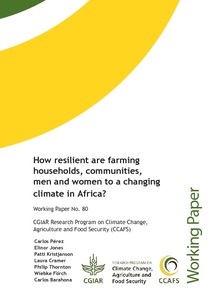Global versus local environmental impacts of grazing and confined beef production systems
Carbon footprint is a key indicator of the contribution of food production to climate change and its importance is increasing worldwide. Although it has been used as a sustainability index for assessing production systems, it does not take into account many other biophysical environmental dimensions more relevant at the local scale, such as soil erosion, nutrient imbalance, and pesticide contamination.
Hillside agroecosystem: Andean region: Rio Ovejas watershed
Hillsides Program
G-Range: development and use of a beta global rangeland model
In April of 2010, Drs. Mario Herrero and Philip Thornton of the International Livestock Research Institute contracted with Drs. Boone and Conant to create a global rangeland model of moderate complexity. Boone was funded for a 50 day effort, and Conant for ca. 40 days. An opportunity to prepare a manuscript for a special issue of the Proceedings of the National Academy of Science arose, and Conant took the lead in that effort. Boone created the rangeland model, called G-Range, with input from Conant, drawing upon existing models and new information (see Acknowledgements).
Greenhouse Gas Emissions from Intermittently Flooded (Dambo) Rice under Different Tillage Practices in Chiota Smallholder Farming Area of Zimbabwe
Agriculture is one of the biggest sources of greenhouse gases. Rice production has been identified as one of the major sources of greenhouse gases, especially methane. However, data on the contributions of rice towards greenhouse gas emissions in tropical Africa are limited. In Zimbabwe, as in most of Sub-Saharan Africa, there are very few studies that have explored greenhouse gas emissions from agricultural lands. This study reports the first dataset on greenhouse gas emissions from intermittently flooded rice paddies in Zimbabwe.
Groundwater availability and use in Sub-Saharan Africa: a review of 15 countries
Traditionally, the spread and extent of human settlement beyond the major riparian zones of Sub-Saharan Africa (SSA) and across many other arid regions of the world, has been determined by availability of groundwater supplies, accessed through hand-dug wells andsprings. In more recent times, groundwater is the preferred means of supplying water to meet the growing demand of the rural, dispersed communities and the small urban towns across SSA.
How resilient are farming households, communities, men and women to a changing climate in Africa?
Using a 9-country dataset from sub-Saharan Africa, and integrating quantitative household-level analyses with qualitative work, the paper shows that gender relations affect agricultural practices and adaptation. The women farmers in our sample control less land than men, the land they control is often of poorer quality, and their tenure is insecure. Women, more than men, are dependent on internal village groups, as opposed to organizations operating at regional or national levels.
Identification of agro-pastoralists adaptation strategies to climate variability: A case study in Mopti-Mali
Identifying determinants, pressures and trade-offs of crop residue use in mixed smallholder farms in Sub-Saharan Africa and South Asia
Crop residues (CR) have become a limited resource in mixed crop-livestock farms. As a result of the increasing demand and low availability of alternative resources, CR became an essential resource for household activities, especially for livestock keeping; a major livelihood element of smallholder farmers in the developing world. Farmers’ decisions on CR use are determined by farmers’ preferences, total crop production, availability of alternative resources and demand for CR. Interaction of these determinants can result in pressures and trade-offs of CR use.
Identifying constraining and enabling factors to the uptake of medium- and long-term climate information in decision making
We apply a systematic review of peer-reviewed literature to assess constraining and enabling
factors to the uptake of medium- to long-term climate information in a wide range of sectoral
investment and planning decisions. Common applications of climate information are shown to
relate to adaptation of environmental policy and planning, urban planning and infrastructure,
as well as flood and coastal management. Analysis of identified literature highlights five
If we halt deforestation, will the world starve?
Making sure that we will continue to have enough to eat is at the heart of our shared ambitions to mitigate climate change. The United Nations Framework Convention on Climate Change (UNFCCC), the convention that has guided us through the highs and lows of 18 rounds of annual negotiations, states upfront that the reasons to stabilise emissions are threefold: to allow ecosystems to adapt naturally , to enable economic development to proceed in a sustainable manner and to ensure that food production is not threatened .










